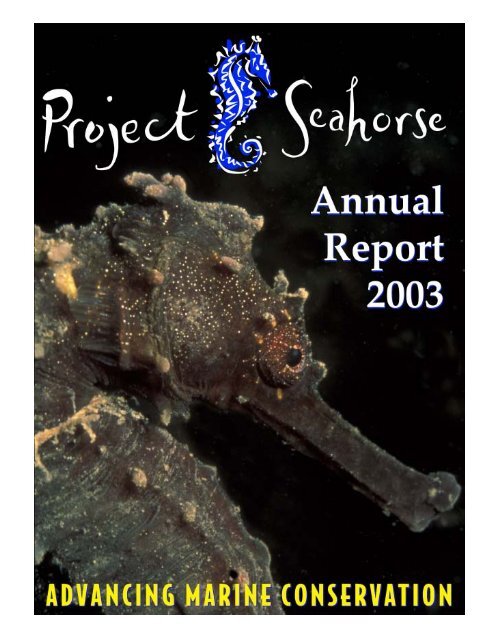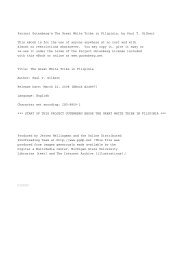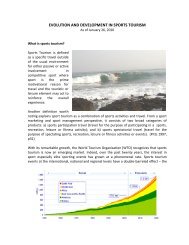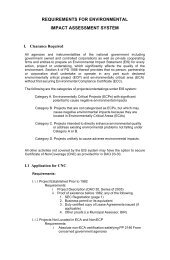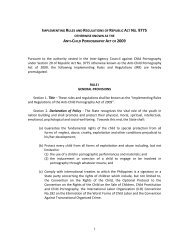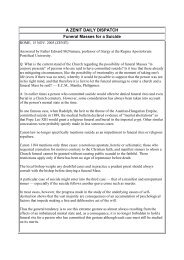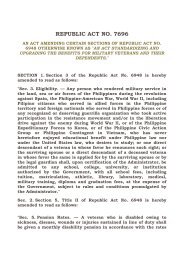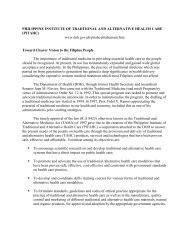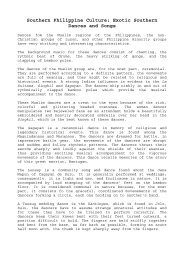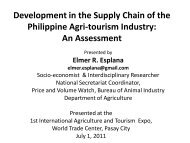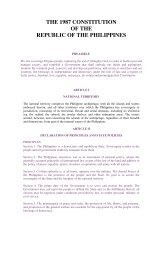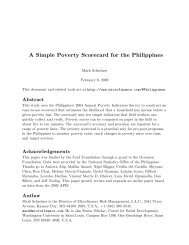Seahorse Research - About the Philippines
Seahorse Research - About the Philippines
Seahorse Research - About the Philippines
You also want an ePaper? Increase the reach of your titles
YUMPU automatically turns print PDFs into web optimized ePapers that Google loves.
page 1
ContentsExecutive Summary 3Policy Development 4Marine Protected Areas 6<strong>Seahorse</strong> <strong>Research</strong> 9Non-food Fisheries <strong>Research</strong> 14Marine Medicinals 15Aquaria 16Sustainable Livelihoods 17Social Development and Outreach 18Publications 19Operations and Finances 20Donors and Sponsors 21The Project <strong>Seahorse</strong> Team 22page 2COVER PHOTO BY KEVIN MARKEYALL OTHER PHOTOS BY PROJECT SEAHORSEEXCEPT WHERE OTHERWISE NOTED
Executive SummaryProject <strong>Seahorse</strong> began 2003 on a high note, having just led a successful campaignto bring all species of seahorses under a global trade regime. The addition ofseahorses to <strong>the</strong> Convention on International Trade in Endangered Species of WildFauna and Flora was a first for marine fishes of commercial importance, creatingnew opportunities – and new challenges – for marine conservation. Thanks to <strong>the</strong>support of our partners and collaborators we are better positioned to tackle thosechallenges than ever before. In Hong Kong, for example, <strong>the</strong> Chinese MedicineMerchants Association formally endorsed our proposed minimum size limit oninternationally traded seahorses. Such support paves <strong>the</strong> way for <strong>the</strong> proposal’sintroduction to <strong>the</strong> international community as we approach implementation of <strong>the</strong>listing in May 2004.The <strong>Philippines</strong> team embraced <strong>the</strong> new year by registering as a non-governmentalorganization, <strong>the</strong> Project <strong>Seahorse</strong> Foundation for Marine Conservation. Under <strong>the</strong>guidance of a new national director, Amado Blanco, our biological research andsustainable livelihoods programs made major strides. The long-term MPAmonitoring program completed a fifth year of field surveys, and we helped set upthree new marine protected areas. The KAMADA fishers alliance of <strong>the</strong> DanajonBank, meanwhile, attracted new members and emerged as a significant voice inregional fisheries management.In Australia, Keith Martin-Smith worked closely with <strong>the</strong> Australian FisheriesManagement Authority on bycatch management and provided input on o<strong>the</strong>rfisheries issues in <strong>the</strong> country. <strong>Seahorse</strong> biology researchers made discoveries in<strong>the</strong> <strong>Philippines</strong> and Portugal, and <strong>the</strong> description of a new species of pygmyseahorse drew worldwide media attention to <strong>the</strong> entire team.The Vancouver headquarters saw its own share of changes in its new offices at <strong>the</strong>University of British Columbia. Two new research assistants and a wildlife tradeanalyst are filling gaps in our understanding of non-food fisheries and o<strong>the</strong>r globaltrade issues and a new four-member operations team has given Project <strong>Seahorse</strong> anenhanced degree of professionalism in program management.The closure of <strong>the</strong> Shedd Aquarium’s <strong>Seahorse</strong> Symphony exhibit marked <strong>the</strong> end ofan enormously successful public education effort in Chicago. But <strong>the</strong> Symphony wasmuch more than that – it was <strong>the</strong> catalyst for <strong>the</strong> Project <strong>Seahorse</strong>-Shedd AquariumPartnership for Marine Conservation. That partnership shows no sign of losingmomentum as we begin <strong>the</strong> final year of our current five-year strategic plan.page 3
Policy Development♦ InternationalOn 13 November 2002, in Santiago, Chile, seahorses became some of <strong>the</strong> firstmarine fish species of commercial importance to be subject to a global trade regime.Member countries of <strong>the</strong> Convention on International Trade in Endangered Species ofWild Fauna and Flora (CITES) voted to add all species of seahorses to Appendix II,which is intended to ensure <strong>the</strong> sustainability of international trade in all listedspecies. Of all wildlife trade issues under international conservation management,seahorses may represent <strong>the</strong> greatest volume when <strong>the</strong> listing takes effect in 2004.Project <strong>Seahorse</strong> later proposed a universal minimum height of 10 centimetres for allHippocampus species as <strong>the</strong> best interim regulatory tool while signatories prepare<strong>the</strong> non-detriment findings required for <strong>the</strong> export of Appendix II species. Weundertook a preliminary meta-analysis of key life-history parameters for comparablemarine fishes. The analysis confirmed that <strong>the</strong> proposed 10-cm limit, which falls ator above <strong>the</strong> maximum height at first maturity for 29 of <strong>the</strong> 33 species, would offer<strong>the</strong>se species some protection, and allow sustainable trade in 22 of <strong>the</strong> 33 species.The limited trade in <strong>the</strong> 11 smaller species involves ei<strong>the</strong>r exclusively domestic orcaptive-breeding facilities. We brought those findings to <strong>the</strong> 2003 meeting of <strong>the</strong>CITES Animals Committee, which will consider <strong>the</strong> proposal in <strong>the</strong> coming months.The success of <strong>the</strong> campaign to list seahorses can be traced to our strategy of firstengaging a variety of stakeholders, preparing numerous briefing documents andcorresponding with <strong>the</strong> media.40353025Htmax (cm)Maximum seahorse heightHtmat (cm)<strong>Seahorse</strong> height at maturityheight (cm)2015possible universalMinHt = 10 cm1050Hippocampus speciespage 4
Also in 2003, Project <strong>Seahorse</strong>, as <strong>the</strong> volunteer Red List Authority for syngnathids,revised <strong>the</strong> IUCN Red Listings of seahorses. In summary, 23 seahorse species arelisted as Data Deficient, nine as Vulnerable and one as Endangered.♦ <strong>Philippines</strong>Much of <strong>the</strong> policy work at <strong>the</strong> Foundation’s Cebu headquarters focused onamending a section of <strong>the</strong> <strong>Philippines</strong> Fisheries Code that has been interpreted asforbidding collection of all CITES-listed species. If collection of all CITES species hasindeed been prohibited, even sustainable fishing would be unavailable tosubsistence fishers. The implementation of <strong>the</strong> seahorse listing onThe 2003Appendix II of CITES in May 2004 and a mandatory government review of Red List isavailable<strong>the</strong> Code provided a degree of urgency. We presented a draft proposal toonline atallow for <strong>the</strong> collection of Appendix II species at several national andwww.redlist.orgregional conferences, including <strong>the</strong> World Wildlife Fund-organized Revisionof Fisheries Code workshop in July and <strong>the</strong> Fourth Visayas FisherfolkAssembly in September. At <strong>the</strong> local level, we worked with <strong>the</strong> federation of fisherson <strong>the</strong> Danajon Bank, KAMADA, which issued its own position statement supporting<strong>the</strong> moves to amend <strong>the</strong> Code and endorsing our proposal for a minimum size limitfor traded seahorses. And following a national consultative workshop we cosponsoredlater in <strong>the</strong> year, seahorse traders and exporters issued a statementasking Congress to allow sustainable trade in seahorses.O<strong>the</strong>r policy work in <strong>the</strong> <strong>Philippines</strong> included <strong>the</strong> continuation of our campaign toend illegal fishing in northwestern Bohol, with <strong>the</strong> help of KAMADA, <strong>the</strong> alliance offishers in <strong>the</strong> Danajon Bank. Their efforts paid off and KAMADA is now preparing toparticipate in law enforcement as fisheries wardens engage in surveillance patrols.♦ AustraliaAustralian initiatives focused on sustainability assessments under <strong>the</strong> EnvironmentProtection and Biodiversity Conservation Act, which requires all fisheries exports tobe accredited by <strong>the</strong> end of 2004. Syngnathids are protected species in Australia,although <strong>the</strong>y are caught as incidental bycatch in several fisheries. Project <strong>Seahorse</strong>has provided expert input on <strong>the</strong>se sustainability assessments and we are pleased tonote that increased assessment of <strong>the</strong> effects of trawling on syngnathids has formedpart of <strong>the</strong> approval conditions for a number of fisheries.Project <strong>Seahorse</strong> policy programs were made possible by our partner organization,<strong>the</strong> John G. Shedd Aquarium, which provided support for our work at CITES; <strong>the</strong>School of Zoology at <strong>the</strong> University of Tasmania, which provided necessaryinfrastructure and an appropriate academic environment for biological research; andChocolaterie Guylian N.V. of Belgium, which provided salary support for many of <strong>the</strong>team members involved in <strong>the</strong> above accomplishments.page 5
Marine Protected Areas♦ Establishing New MPAs in <strong>the</strong> <strong>Philippines</strong>Twelve marine protected areas have now been established as part of a Project<strong>Seahorse</strong> research program that explores both <strong>the</strong> ecological dynamics and <strong>the</strong>community-derived indicators of success. The process includes participatory coastalresource assessment, siting consultation, fulfilment of legal requirements, and <strong>the</strong>creation of management councils. All MPAs are managed at <strong>the</strong> village, or“barangay,” level, and function as no-take marine sanctuaries, primarily protectingshallow, fringing reefs, seagrass beds and mangroves within <strong>the</strong> inshore coast of <strong>the</strong>Danajon Bank reef complex of nor<strong>the</strong>rn Bohol, central <strong>Philippines</strong>.In 2003, <strong>the</strong> <strong>Philippines</strong> team helped initiate three new MPAs, one new MPA inbarangay Sinandigan, Ubay, and two in barangay Saguise, Carlos P. Garcia. Weconducted baseline surveys, provided technical assistance in determining <strong>the</strong>boundaries of each MPA and mapping <strong>the</strong> areas, and helped draft local legislation todeclare <strong>the</strong> sites as no-take MPAs. Local government agencies co-financed <strong>the</strong>activities and <strong>the</strong> local KAMADA chapters were instrumental in mobilizing communityparticipation in <strong>the</strong> consultative meetings, providing fur<strong>the</strong>r evidence our communityorganizing effort is bearing fruit.♦ Long-term MPA MonitoringOur unique program based in Bohol, central <strong>Philippines</strong>, tracks <strong>the</strong> effectiveness ofMPAs in providing protection to coastal habitat and enhancing abundance andbiomass of marine species, including seahorses. In 2003, we conducted a full suiteof surveys of seven MPAs (Batasan and Bilangbilangan in Tubigon, Asinan inBuenavista, Handumon, Jandayan Norte and Pandanon in Getafe, and Pinamgo in BienUnido) and in four control sites (Canlangi in Tubigon, Pandao in Buenavista, Sag inTalibon and Putik in Getafe) in <strong>the</strong> dry and rainy seasons.Monitoringan MPAA team of biologists andvolunteers led by HabitatBiologist Brian Cabreramonitored benthic fauna andflora percentage cover,number and size of fin-fishand resident seahorsepopulations. Results revealedincreased abundance ofmedium to large mid- andtop-trophic-level fishesinside three MPAs comparedwith outside <strong>the</strong> sanctuariesand associated control sites.The o<strong>the</strong>r sites showed nodifference in abundancepage 6
etween inside- and outside-MPA locations, potentially indicating poor enforcement.There was little difference or change in percentage live coral, dead coral or rubblecover inside compared with outside <strong>the</strong> MPAs, but cover was higher both inside andoutside MPAs compared with <strong>the</strong> control sites over a three to five-year period.Documentation of <strong>the</strong> community feedback sessions after <strong>the</strong> wet season surveysindicated a strong correlation between good enforcement of certain MPAs conductedby local communities and observed increases in fish abundances. Such resultsencourage <strong>the</strong> maintenance of voluntary patrols undertaken by local fishers. Whereresults appeared less conclusive, communities identified poorenforcement as a possible reason for <strong>the</strong> lack of change in fishabundance within <strong>the</strong>ir MPA. These communities did, however,identify ways to improve enforcement, such as <strong>the</strong> building ofguardhouses and replacement of marker buoys demarcating MPAboundaries. The involvement of communities has and will continueto provide important insights with regard to interpretation of <strong>the</strong>monitoring datasets for improved local management of marinesanctuaries.♦ Coral Reef RehabilitationThe majority of our MPAs in <strong>the</strong> central <strong>Philippines</strong> encompass shallow, near-shore,fringing reefs in naturally turbid conditions. Signs of degradation – particularly fromblast fishing – are evident in <strong>the</strong> presence of rubble and seaweed and <strong>the</strong> absence oflive hard coral. A 12-month study was initiated in 2002 within one MPA to test <strong>the</strong>effects on coral recruitment and growth of removing algae. We also measured fishcommunity diversity and abundance. A low-tech, small-scale, participatorytechnique was applied in <strong>the</strong> form of a repeated algal cropping trial. Five treatmentsites and five controls were marked and algae repeatedly removed from <strong>the</strong>treatment plots. The plots were surveyed monthly for assessment of temporalchanges in benthic composition and associated fishes presence and abundance.Coral reef lifeFunding for establishing and monitoring MPAs was supplied by <strong>the</strong> John G. SheddAquarium and <strong>the</strong> Community Fund of <strong>the</strong> U.K.♦ Integrated Study of Community-based MPAsOur study of <strong>the</strong> biological, socio-economic and anthropological dimensions ofmarine protected areas made significant progress in its third year. Demographic andbiological surveys have been completed, new field sites have been added, andmonitoring protocols are in place. The three doctoral students spent much of 2003analyzing <strong>the</strong> initial datasets ga<strong>the</strong>red from <strong>the</strong> first and second field seasons inBohol, <strong>Philippines</strong>, and continuing <strong>the</strong> collection and management of field data. Allthree students are prepared for <strong>the</strong>ir third field season, which <strong>the</strong>y will tackle withwell-managed databases and well-trained research assistants.page 7
Socio-economic and biological determinants of MPA success: Marivic PajaroThe 2003 field season laid <strong>the</strong> groundwork for <strong>the</strong> next phase of Marivic’sresearch program by developing <strong>the</strong> participatory instruments required to monitorMPA effectiveness. Community volunteers from seven study sites collected data on<strong>the</strong> indicators <strong>the</strong>y agreed to monitor. Her preliminary analysis of <strong>the</strong> interviewresults suggests that <strong>the</strong> age of MPAs may influence perceptions amongcommunities in <strong>the</strong>ir definition of goals and indicators of effectiveness. The mostrecent field season also provided <strong>the</strong> material for a paper to be presented to <strong>the</strong>2004 International Coral Reef Symposium in Okinawa, Japan.Cultural and institutional correlates of MPA effectiveness: Eulalio GuiebMuch of 2003 was devoted to <strong>the</strong> completion of academic requirements and <strong>the</strong>organization of fieldwork data ga<strong>the</strong>red so far. Already, Eulalio has produced a seriesof geographical information system maps of local place names, households,traditional fish shelters, MPAs, village territorial boundaries, selected terrestrial andmarine resources, and o<strong>the</strong>r resources of anthropological importance, such as watertanks and wells. Life histories of selected interviewees and resource-use history from<strong>the</strong> two research sites have been transcribed in full, and all have been translatedfrom Cebuano into Filipino. Archival work on <strong>the</strong> ethnography and anthropology ofVisayan coastal villages will continue in 2004.Responses of fish and benthic habitat communities to MPAs: : Jonathan AnticamaraJonathan’s research now gives equal emphasis to understanding <strong>the</strong> responses offish and benthic habitat communities, and he added two fishing reefs as referencesfor his six MPA study sites. A baseline paper has been drafted and a video survey ofall study sites was recorded for comparison with future conditions. Monthly visits,feedback and discussion sessions with local communities and o<strong>the</strong>r stakeholdersfacilitated smooth fieldwork operations and also proved critical for maintainingcollaboration. In addition, Jonathan helped train <strong>the</strong> staff of several northwesternBohol municipalities in MPA monitoring techniques, including visual census methodsand recording GPS coordinates.Integrated MPA research was funded by <strong>the</strong> International <strong>Research</strong> DevelopmentCentre of Canada and John D. and Ca<strong>the</strong>rine T. MacArthur Foundation of Chicago.♦ MPA <strong>Research</strong> in British ColumbiaJoining <strong>the</strong> team in September was PhD student Natalie Ban. Her study of designingmarine protected areas will focus on British Columbia, a geographical first for <strong>the</strong>team. She will examine various MPA-designation criteria, comparing <strong>the</strong> use ofscience with relying on local stakeholders and <strong>the</strong>ir traditional knowledge. Theresults will improve our understanding of MPA design and produce a methodologythat can help identify an ecologically effective and representative set of MPAs.page 8Natalie’s research was supported by <strong>the</strong> Natural Sciences and Engineering <strong>Research</strong>Council of Canada and <strong>the</strong> Canadian Parks and Wilderness Society.
<strong>Seahorse</strong> <strong>Research</strong>♦ Biological <strong>Research</strong> and Management in AustraliaOur biological research, bycatch studies, and fisheries management program inAustralia take advantage of <strong>the</strong> world’s highest known syngnathid diversity andsome of <strong>the</strong> most sophisticated fisheries conservation efforts anywhere. All activitiesare conducted under <strong>the</strong> supervision of Keith Martin-Smith at <strong>the</strong> University ofTasmania in Hobart.The core syngnathid research, on <strong>the</strong> life-history parameters of two seahorsespecies, <strong>the</strong> big-bellied seahorse (Hippocampus abdominalis) and <strong>the</strong> Sydneyseahorse (H. whitei), is yielding surprising results. Using fluorescent pigments tomark more than 180 big-bellied seahorses at three sites in <strong>the</strong> River Derwent inTasmania, we found that <strong>the</strong>se seahorses can move considerable distances. Sixanimals were recorded traveling more than 2.5 kilometres in as few as 26 days.O<strong>the</strong>r species chosen for study include <strong>the</strong> spiny pipehorse (Solegnathusspinosissimus) and <strong>the</strong> weedy seadragon (Phyllopteryx taeniolatus) through MarleneDavey’s PhD project. While <strong>the</strong> spiny pipehorse is caught as incidental bycatch in fishand shrimp trawls, almost nothing is known about its ecology. The weedy seadragonis a marine icon. We collected data on growth, reproduction and movement in bothspecies. Honours student Danial Marshall, meanwhile, investigated <strong>the</strong> use ofartificial structures such as nets andjetties by seahorses and <strong>the</strong> factors thatinfluence <strong>the</strong>ir choice of habitat.InjectingHippocampusabdominaliswith a tag.Ano<strong>the</strong>r honours student, Ryuji Sakabe,completed his study on <strong>the</strong> feedingecology of <strong>the</strong> spotted pipefish(Stigmatopora argus) and its relationshipwith seagrass complexity. Experiments in<strong>the</strong> laboratory showed that spottedpipefish always selected a high density ofartificial seagrass regardless of <strong>the</strong>distribution of prey items, suggestingthat an important role of seagrassas a refuge from predators.Support for Keith Martin-Smith’sresearch was provided by ChocolaterieGuylian N.V. of Belgium.page 9
♦ Population Viability Analysis (Portugal)Fascinating aspects of seahorse biology are emerging from our field research inPortugal. Unusually high densities of Hippocampus guttulatus and H. hippocampusmake <strong>the</strong> Ria Formosa lagoon, which extends along 60 kilometres of <strong>the</strong>Mediterranean coast, an ideal site for such research. Our studies <strong>the</strong>re have alreadyshed light on life histories, reproductive behaviour, population structure and habitatuse patterns. In 2003, we returned to monitor survival and growth rates, <strong>the</strong> degreeof site fidelity and home range sizes for both species. The successful re-sighting ofseveral hundred previously tagged seahorses allowed us to estimate a year’s worthof winter growth and survival rates.PHOTO BY PAULO MACHADOHippocampusguttulatusBased at <strong>the</strong> Department of Biology at McGillUniversity in Montreal, PhD candidate andfield biologist Janelle Curtis is using <strong>the</strong> RiaFormosa data to develop rigorous fisheriesindependentassessment techniques knownas population viability analysis (PVA) models.Because studies of natural seahorsepopulations are few and urgently required toassess <strong>the</strong>ir conservation status, her effortshave centered on collecting biologicalinformation <strong>the</strong> models require. Anevaluation of <strong>the</strong> impacts of fishing andhabitat loss is also underway.Much of <strong>the</strong> research and educational workwas <strong>the</strong> contribution of a cooperative teamof international research assistants andwork-study students (Belinda Gunn, Sebastien Lemieux and Melisa Veillette). The incountryresearch benefited greatly from <strong>the</strong> assistance of faculty, students, and staffat Universidade do Algarve and <strong>the</strong> Parque Natural da Ria Formosa. In 2003, JeanMarcus joined <strong>the</strong> team for a week to assist with underwater research and learnabout <strong>the</strong> ecosystem, in preparation for post-doctoral research in 2004.The results of <strong>the</strong> study of <strong>the</strong> impacts of small-scale, non-selective exploitation on<strong>the</strong> population structure of threatened European seahorses will be presented at <strong>the</strong>2004 Canadian Conference for Fisheries <strong>Research</strong> in St. John’s, Newfoundland, and<strong>the</strong> 2004 World Fisheries Congress in Vancouver. Janelle is currently writing fiveresearch papers directly related to her PhD <strong>the</strong>sis and at least three papers relatingto data collected and analyzed during her field work in Portugal.The Portugal research program was carried out with <strong>the</strong> generous support ofChocolaterie Guylian N.V. of Belgium.page 10
♦ Rapid Assessment Program (<strong>Philippines</strong>)Our knowledge of <strong>the</strong> composition of seahorse communities in <strong>the</strong> <strong>Philippines</strong> isexpanding thanks to <strong>the</strong> combined efforts of Project <strong>Seahorse</strong> biologists and trainedfishers. The Rapid Assessment Program (RAP) operated in selected nation-wide sites,documenting <strong>the</strong> status of seahorse populations as perceived by local fishers andbuilding <strong>the</strong> capacity of <strong>the</strong> fishers in coastal resource management. The ecologicalassessments of wild fish populations and associated habitats produced by <strong>the</strong>program will be integral to <strong>the</strong> development of sound conservation strategies.The end of 2002 saw <strong>the</strong> completion of site consultations andsurveys in 27 locations across five provinces in <strong>the</strong> <strong>Philippines</strong>. In2003, seahorse and biophysical data were encoded, analyzed anddocumented. <strong>Seahorse</strong> densities for each of <strong>the</strong> survey locationswere calculated and benthic communities classified usingpercentage cover estimates of major sessile benthic categories andmultivariate analytical techniques. Six biological community typesand four species of seahorses were recorded. The most abundantand widespread species was Hippocampus comes. H. barbouri wasrecorded only in Palawan and two o<strong>the</strong>r species, H. kuda and H.spinosissimus, were only sighted once each. Results andmanagement recommendations have been collected in a draftmanuscript that is near to completion. Documentation of <strong>the</strong>perceptions study component of RAP is also underway.The RAP program was supported by <strong>the</strong> Pew Fellows Program inMarine Conservation.♦ Behaviour of Juvenile <strong>Seahorse</strong>s (<strong>Philippines</strong>)PhD student Siân Morgan’s research is focused on data collection at her field site onCataban Island in Bohol, <strong>Philippines</strong>, where she is studying <strong>the</strong> behaviour of seahorsejuveniles. She carried out in situ observations of newly released young, planktontows, and benthic transects. Divers followed <strong>the</strong> young underwater over shallow reefflats, regularly recording depth and orientation relative to ambient current. Siân andher research assistants discovered that seahorse young were most common in wildmacroalgal beds, whereas adults were more common on coral crests. In addition,<strong>the</strong>y collected data on a compressor-based sea cucumber fishery at Cataban that isbeing replaced by a fishery for <strong>the</strong> hedgehog seahorse (Hippocampus spinosissimus).Data collection at Cataban was undertaken with <strong>the</strong> help of research assistant HazelPanes, who is continuing <strong>the</strong> seahorse fishery monitoring as a staff biologist with <strong>the</strong>Project <strong>Seahorse</strong> Foundation for Marine Conservation.HippocampuscomesHippocampuscomesPHOTO BY KEVIN MARKEYSian’s research was supported in part by <strong>the</strong> People’s Trust for Endangered Species,<strong>the</strong> Natural Sciences and Engineering <strong>Research</strong> Council of Canada and McGillUniversity.page 11
PHOTO BY JOERG ADAMSara LourieexaminesHippocampusdenisespecimens.♦ Phylogeography of Sou<strong>the</strong>ast Asian <strong>Seahorse</strong>sSara Lourie submitted her PhD <strong>the</strong>sis as <strong>the</strong> year drew to a close. Based at McGillUniversity in Montreal, she is studying genetic patterns among populations ofseahorses with respect to <strong>the</strong> geological history of Sou<strong>the</strong>ast Asia. One chapter of<strong>the</strong> <strong>the</strong>sis – using biogeography to set priorities in marine conservation – is in press,and three o<strong>the</strong>r papers are in preparation. Her research uncovered surprisingpatterns that reflect <strong>the</strong> different habitats and ecology among four species and mayhave implications for conservation plans. She presented some of that work at <strong>the</strong>inaugural International Biogeography Conference inNevada. O<strong>the</strong>r highlights of <strong>the</strong> year included <strong>the</strong>publication in Zoological Studies of a paper, co-authoredwith John Randall, describing Hippocampus denise, a newspecies of pygmy seahorse and <strong>the</strong> smallest yet known.The paper attracted considerable media attention, leadingto radio and television interviews and print and electronicarticles. Sara also continued to look after <strong>the</strong> Project<strong>Seahorse</strong> specimen collection with <strong>the</strong> assistance of JulieNadeau, provided taxonomic identifications of specimensand photographs, and contributed to a new seahorse identification guide for CITES.Sara’s studies were supported by McGill University.♦ Fisheries Management (<strong>Philippines</strong>)We have been monitoring a small-scale fishery supplying seahorses (Hippocampuscomes) for export, ei<strong>the</strong>r dried for traditional medicines or live for aquarium display,since 1996 in nor<strong>the</strong>rn Bohol. The community-based monitoring program usesfishers’ log books to ga<strong>the</strong>r information on <strong>the</strong> size and status of <strong>the</strong> fishery for usein <strong>the</strong> development of management measures. Originally established in one focalcommunity (barangay Handumon, Jandayan Island) in 1996, <strong>the</strong> project expanded tonine o<strong>the</strong>r seahorse fisher communities in 2000. In 2003, fishers from eightcommunities completed log books. Fisheries biologist Armi May Torrechilladistributed calendars at <strong>the</strong> beginning of each month and conducted regular sitevisits during collection periods to encourage and check participation. In parallel with<strong>the</strong> “catch calendar” collection, we collected catch landings data within <strong>the</strong> samemonths in Handumon. Databases for both long-term monitoring programs havebeen checked and data verified by Senior <strong>Research</strong> Assistant Brian Giles. We alsocarried out a small investigation of <strong>the</strong> measuring standards employed by biologistsand local research assistants to ensure <strong>the</strong> data were compatible.We also tracked a “boom and bust” fishery for a population of <strong>the</strong> H. spinossismusthrough to its eventual collapse. From July, our team conducted monitored landingsdaily to assess <strong>the</strong> health of <strong>the</strong> fishery and <strong>the</strong> status of <strong>the</strong> population. The datashow a rapid decline in catch per unit effort and evidence of serial depletions of <strong>the</strong>fishing grounds.page 12
Late in <strong>the</strong> year we launched a foodfish monitoring program to gauge catchesoutside protected areas. Spill-over effects are one benefit to local communities insupporting <strong>the</strong>ir MPAs as documented by many studies, including one on ApoIsland, Negros Oriental, central <strong>Philippines</strong>.PhD student Mary Cashman joined <strong>the</strong> team in September. Since <strong>the</strong>n, she hascompleted fisheries and resource management coursework at UBC, and begun todevelop her doctoral research program. She will examine <strong>the</strong> biological andenvironmental impacts of fishers’ decisions on <strong>the</strong> Danajon Bank in <strong>the</strong> <strong>Philippines</strong>by means of underwater observations and monitoring of fishing grounds.Support for bycatch research was provided by <strong>the</strong> John G. Shedd Aquarium.Mary’s studies were supported by <strong>the</strong> U.S. National Science Foundation.♦ Bycatch <strong>Research</strong>Project <strong>Seahorse</strong> published <strong>the</strong> first study to directlyexamine <strong>the</strong> distribution, number, and catch per unit effortinvolved in <strong>the</strong> incidental capture of seahorses. Conductedby Julia Baum in Florida, <strong>the</strong> research showed thatsubstantial numbers of seahorses were caught in shrimptrawls as bycatch. Although <strong>the</strong> effects on populations ofseahorses could not be directly ascertained, <strong>the</strong>re werereports from fishers of declining numbers in catches.Bycatch inPakistanThe bycatch of o<strong>the</strong>r organisms during fishing operationsis a major threat to marine ecosystems around <strong>the</strong> world.Particular types of fishing gear such as shrimp trawls catchlarge amounts of bycatch, up to 10 times <strong>the</strong> weight of <strong>the</strong>targeted species. In <strong>the</strong> case of seahorses, <strong>the</strong> vast majority traded around <strong>the</strong> worldare caught as bycatch. To ensure <strong>the</strong> long-term sustainability of <strong>the</strong> species we mustfind ways of managing that bycatch. In addition, repeated trawling can causeconsiderable damage to benthic habitat structure and alter <strong>the</strong> structure andfunction of ecosystems.In Australia we are working with fisheries management agencies to find strategies toaddress bycatch of syngnathids. We collaborated with <strong>the</strong> Fisheries ManagementAuthority and <strong>the</strong> Commonwealth Scientific and Industrial <strong>Research</strong> Organization toqualitatively assess <strong>the</strong> vulnerability of syngnathids to trawl fisheries. Syngnathidsare now a priority group for research and monitoring in <strong>the</strong>se fisheries. Also in 2003,we initiated a project to investigate <strong>the</strong> catches of spiny pipehorses (Hippocampusspinosissumus) in <strong>the</strong> sou<strong>the</strong>rn and eastern scalefish and shark fisheries todetermine <strong>the</strong>ir effects on this rare species of syngnathid.Support for bycatch research was provided by Chocolaterie Guylian N.V. of Belgium.page 13
Non-food FisheriesOur examination of <strong>the</strong> nature and scope of non-food fisheries has revealed largegaps in <strong>the</strong> available information on <strong>the</strong> extent of industries involved. For example,little is known about <strong>the</strong> use of fish and invertebrates for research and education, yetfishes represent a quarter of all animals used and only mice have a larger share. Alsopoorly documented are <strong>the</strong> fish lea<strong>the</strong>r and curiosity trades.<strong>Research</strong> Assistants Melissa Grey and Bob Hunt collaborated with Amanda Vincent on<strong>the</strong> first comprehensive reviews of <strong>the</strong> non-food fisheries. They catalogued morethan 80 species used in North America for research and education alone.Invertebrates, though difficult to assess because reporting is voluntary, mayrepresent more than a third of all animals used. Nearly half <strong>the</strong> fish used in researchand education are wild-caught, but as few researchers include provenance in <strong>the</strong>irstudies, it is difficult to predict effects on wild populations.The North American curio trade, meanwhile, represents an added pressure onstressed ecosystems. Dried fish, shells, crafts and jewelry sold as curios are typicallyfrom tropical reef habitats. The <strong>Philippines</strong> is a major exporter of <strong>the</strong>se goods and<strong>the</strong> United States a major importer. Minimum estimates indicate that imports ofwhole dried fishes are worth at least US$198,000 annually and involve 33 species.Invertebrate statistics are difficult to estimate but we suspect <strong>the</strong> scale of <strong>the</strong> trade ismuch larger and includes at least 24 species of echinoderms and arthropods.Hagfishes, sharks and stingrays, all characterized by a low reproductive potential,are particularly prized in <strong>the</strong> North American fish lea<strong>the</strong>r market. All lea<strong>the</strong>r fisheriesare open-access, and absorb <strong>the</strong> excess capacity from o<strong>the</strong>r regulated fisheries.Unfortunately, basic information on natural density and growth rates is severelylimited.There may be less concern over <strong>the</strong> collection of marine organisms for <strong>the</strong>development of drugs. Advances in technology over <strong>the</strong> last 30 years have led toreductions in <strong>the</strong> demand for initial bioprospecting samples. Through advances innatural products chemistry, researchers are finding syn<strong>the</strong>tic alternatives to supply<strong>the</strong> compounds necessary for drug development. Still, confidentiality agreementsmake it difficult to verify <strong>the</strong> sustainability of <strong>the</strong> industry.The manufacture of industrial, agricultural, biomedical and miscellaneous naturalproducts also consumes marine species. While living specimens are more commonlyused in environmental services, industry prefers <strong>the</strong> advantages of syn<strong>the</strong>ticproduction or culture to reliance on <strong>the</strong> harvest of wild populations. There are stillsignificant capture fisheries for biotechnology, however, including one for <strong>the</strong>horseshoe crab, whose blood clotting agent can detect bacterial toxins.The non-food fisheries research program was supported by <strong>the</strong> Pew Fellows Programin Marine Conservation.page 14
Marine MedicinalsEngaging stakeholders in <strong>the</strong> trade is critical if we are to adjust consumption levelsof seahorses. In 2003, <strong>the</strong> Hong Kong Chinese Medicine Merchants Association, astrong partner of our Marine Medicinals Conservation Program in Hong Kong, sent aletter to <strong>the</strong> trade regulators and exporters in <strong>the</strong> <strong>Philippines</strong> expressing its supportfor a recommended minimum size limit of traded seahorses. The association alsoinvited our representative to write an article for a biennial report when it celebratesits 75th anniversary this coming October.That positive relationship represents a major achievement of <strong>the</strong> program, which wehave run in partnership with WWF Hong Kong and TRAFFIC East Asia since 1998. Theprimary goal is to ensure that consumption of seahorses and o<strong>the</strong>r marine speciesused in traditional Chinese medicine (TCM) is sustainable. A major consumer itself ofseahorses, Hong Kong is thought to be <strong>the</strong> world’s largest trading hub for TCMproducts destined for China and o<strong>the</strong>r consumers of Asian traditional medicine. Mostconcerns over unsustainable use of plants and animals in traditional medicine havefocused on charismatic large mammals, with little attention paid to hundreds ofmarine species. We seek to understand <strong>the</strong> impact of such trade, and to develop andpromote remedial conservation measures.This year, we tracked minor changes in <strong>the</strong> international seahorse trade. A Review ofHong Kong import data revealed <strong>the</strong> emergence of <strong>the</strong> U.S. and Australia in <strong>the</strong> trade.Key declared sources were Thailand and <strong>the</strong> <strong>Philippines</strong>, collectively providing nearly90% of <strong>the</strong> imports. We also noticed <strong>the</strong> declining significance of India (once among<strong>the</strong> top three) on import data, as well as China (<strong>the</strong> largest net importer) onre-export records, and realized <strong>the</strong> data could be used as an “early warning system”to identify areas that need attention. Cambodian exports, meanwhile, appeared for<strong>the</strong> first time in Taiwan Customs data.We gratefully acknowledge past financial support from <strong>the</strong> UK Department of <strong>the</strong>Environment, Food and Rural Affairs and from GlaxoSmithKline plc. Support for 2003came from <strong>the</strong> John G. Shedd Aquarium in Chicago.TCM productspage 15
AquariaThe seahorse husbandry and management program continues to operate through<strong>the</strong> engagement of North American and European aquaria and <strong>the</strong>ir respective TaxonAdvisory Groups. In North America, <strong>the</strong> syngnathid program is co-ordinated by JeffMitchell of <strong>the</strong> John G. Shedd Aquarium while Hea<strong>the</strong>r Hall of Project <strong>Seahorse</strong> and<strong>the</strong> Zoological Society of London and Michael Laterveer of <strong>the</strong> Rotterdam Zoo overseeEuropean activities. The Project <strong>Seahorse</strong>/John G. Shedd Partnership for MarineConservation continues to act as a focal point, providing direction and encouragingmany of <strong>the</strong> outputs.We added new chapters on <strong>the</strong> two species of seadragon and <strong>the</strong> seahorseHippocampus abdominalis to an updated version of <strong>the</strong> <strong>Seahorse</strong> Husbandry Manual,which will be edited and re-distributed in 2004. Breeding and research efforts havefocused on 11 priority seahorse species and two seadragons. Particular advanceshave been made for H. capensis at <strong>the</strong> Rotterdam Zoo (Ne<strong>the</strong>rlands), Antwerp Zoo(Belgium) and National Marine Aquarium (Plymouth UK) with field workers, researchbiologists and aquariums cooperating on ex situ breeding, research, and education.Much of <strong>the</strong> correspondence and activity for <strong>the</strong> program is conducted via <strong>the</strong>Syngnathidae listserv, which grew to 195 members. The majority of <strong>the</strong>discussions related to disease treatments, exchanges of captive bred animals, o<strong>the</strong>rhusbandry issues and information dissemination on seahorse-related issues. The listwas used to compile photographs of common seahorse diseases for a field referenceguide by Project <strong>Seahorse</strong> biologists working on a seahorse caging trial.A number of o<strong>the</strong>r aquaria remain involved in small-scale research onnutrition, disease, and behaviour, usually in collaboration with localresearch organizations. Several contributed data for a seahorse lifehistory review by Sarah Foster and Amanda Vincent. The paperidentified gaps in knowledge, and it will be used to guide aquariumresearch after it is published by <strong>the</strong> Journal of Fish Biology in 2004.<strong>Research</strong> at <strong>the</strong>London ZooWe also provided assistance, from husbandry advice to images andinformation, for new syngnathid exhibits and special events at several aquaria,including <strong>the</strong> Point Defiance Zoo and Aquarium (U.S.A.), Long Beach Aquarium(U.S.A.) and Anglesey Sea Zoo (U.K.). The number of aquariums now selling craftsproduced by <strong>the</strong> KANAGMALUHAN cooperative in <strong>the</strong> <strong>Philippines</strong> and exported byProject <strong>Seahorse</strong> also grew in 2003. The list now includes <strong>the</strong> John G. SheddAquarium, London Zoo, Anglesey Sea Zoo, Monterey Bay Aquarium (U.S.A.), SeattleAquarium (U.S.A.), Tennessee Aquarium (U.S.A.), and Nausicaa Aquarium (France).And in anticipation of <strong>the</strong> implementation of <strong>the</strong> CITES listing in 2004, we liaisedwith <strong>the</strong> CITES team at London’s Heathrow Airport to investigate <strong>the</strong> role of aquariain dealing with seized live seahorses.page 16Aquarium activities were supported by <strong>the</strong> John G. Shedd Aquarium and <strong>the</strong>Zoological Society of London.
Sustainable LivelihoodsProject <strong>Seahorse</strong> continues to support KANAGMALUHAN, <strong>the</strong> people’s organizationwe established in <strong>the</strong> village of Handumon on Jandayan Island in Bohol. Besidesorganizing various training activities, Livelihood Business Officer Rachel Malabananreviewed <strong>the</strong> KANAGMALUHAN craft initiative by interviewing members of <strong>the</strong>households and holding interactive focused group discussions. The review showedthat <strong>the</strong> crafts trade is financially rewarding, but not a constant source of income;members are producing crafts three to four months out of <strong>the</strong> year, for about twoweeks per month. While an order is being filled, some fishers refrain from fishing.The harvesting of <strong>the</strong> romblon plant (Pandanus spp.) used for handicrafts appears tohave no negative effect on <strong>the</strong> natural environment, and replanting and stockmonitoring have been introduced by KANAGMALUHAN.Livelihood Biologist Roger Bayutas, meanwhile, conducted an in-depth profile ofaquaculture practices in 10 Danajon Bank villages. The profile showed that seaweedfarming is <strong>the</strong> most widespread aquaculture practice. Although <strong>the</strong> environmentalimpact of seaweed farming appeared low, it requires a formal assessment before itcan be promoted as an alternative livelihood. Grouper is also commonly farmed, hasa high market demand and provides returns on investment, but requires an in-dep<strong>the</strong>cological analysis as well. Milkfish farming, however, is clearly detrimental due toheavy pesticide and fertilizer use and destruction of mangroves to create fish ponds.Comprehensive socio-economic data on lantern fishers and <strong>the</strong>ir familiescollected in 2001 and 2002 were analyzed by Social Development andLivelihood Coordinator Thomas Jacobsen, Community Organizer JoelErediano and Projects Coordinator Sophie Oliver. Lantern fishers areamong <strong>the</strong> poorest of <strong>the</strong> poor in <strong>the</strong> <strong>Philippines</strong>. Their average incomeof 4,652 Philippine Pesos ($83 US) per month falls below <strong>the</strong> povertythreshold. Developing sustainable livelihoods is challenging, but wenow understand: (1) how people use <strong>the</strong>ir assets to maximize incomeand minimize vulnerability; (2) which assets <strong>the</strong>y choose to invest in;(3) where <strong>the</strong>y obtain <strong>the</strong> skills necessary to pursue different earningstrategies; and (4) <strong>the</strong> money-saving activities <strong>the</strong>y undertake.KANAGMALUHAN:A weaver at workRecognizing we are not alone in <strong>the</strong> pursuit of environmentallysustainable livelihoods, we organized a two-day workshop in July. Forty participantsfrom 26 institutions, including local governments, NGOs, and academia convened inCebu City to develop a set of indicators to assess <strong>the</strong> impact of livelihoodapproaches. The workshop findings were syn<strong>the</strong>sized into a report by <strong>the</strong> socialdevelopment team of <strong>the</strong> Foundation. Community Organizer Alen Mondido alsopresented a paper on <strong>the</strong> role of environmentally sustainable livelihoods in marineconservation at <strong>the</strong> First National Fisheries Social Science Conference, Iloilo City,<strong>Philippines</strong> in November.Sustainable Livelihood programs were supported in 2003 by <strong>the</strong> John G. SheddAquarium, <strong>the</strong> Columbus Zoo, and <strong>the</strong> Community Fund of <strong>the</strong> UK.page 17
Social Development and Outreach♦ Community OrganizingThe past year saw remarkable progress by KAMADA. Originally an organization oflantern fishers on <strong>the</strong> Danajon Bank, it has evolved into an umbrella federation offishers’ organizations across <strong>the</strong> region. As of year’s end, KAMADA had grown to540 members, with 16 chapters in 15 sites, including one in Cebu Province. TheJandayan Integrated Coastal Development Council made its own mark, becoming aregistered people’s organization and taking a seat on <strong>the</strong> Municipal Fisheries andAquatic Resource Management Council of Getafe.Also high on our priority list were formal and informal relationships with o<strong>the</strong>ragencies and organizations. We signed a memorandum of agreement with <strong>the</strong>Coastal Conservation Education Foundation (CCE Foundation) to ga<strong>the</strong>r, share, store,and analyze information on marine protected areas. The Project <strong>Seahorse</strong> Foundationcollaborated with <strong>the</strong> CCE Foundation and organized a training workshop on anational MPA ratings system developed by CCE Foundation. Teams consisting ofmarine biologists and social scientists from both NGOs developed standardizedunderwater biophysical assessments and community social profiles. Developmentworkers with <strong>the</strong> German Development Service and <strong>the</strong> technical staff of <strong>the</strong> BoholEnvironmental Management Office also attended. In addition, we streng<strong>the</strong>ned tieswith two fishers federations, <strong>the</strong> PAMANA ka sa Pilipinas, a national alliance ofmarginal fishers and communities managing MPAs, and Kilusang Mangingisda –Visayas, as allies in fisheries reform and marine conservation.♦ Information, Education and CommunicationIn <strong>the</strong> <strong>Philippines</strong>, our community organizers and information officer hostedfeedback sessions on research activities at <strong>the</strong> community and municipal levels inTalibon, Ubay, Getafe, and Tubigon. We mounted photo exhibits at <strong>the</strong> VisayasFisheries forum in Cebu, World Earth Day in Getafe and World Environment Day inHandumon, and during Science Month in Southwestern University in Cebu. TheMarine Apprenticeship Program supported one college student and nine high schoolscholars, who collectively maintained a model organic garden located in Handumon.Our staff also produced and distributed a series of documents in support ofcommunity-based coastal resource management, policy advocacy and biology in2003.The addition of a communications coordinator in <strong>the</strong> Vancouver headquarters led toa marked improvement in both internal and external information flow. The Project<strong>Seahorse</strong> website was overhauled and relaunched, <strong>the</strong> first edition of a quarterlynewsletter (PS News) was published, and lines of communications among <strong>the</strong> team,host institutions, collaborators, <strong>the</strong> public, and news media have been greatlyenhanced. Also available for <strong>the</strong> first time are online catalogs of <strong>the</strong> team’s librariesof photographs, books and media coverage.page 18Communications and outreach efforts were made possible through <strong>the</strong> support of<strong>the</strong> John G. Shedd Aquarium and <strong>the</strong> Community Fund of <strong>the</strong> U.K.
Publications 2003Baum, Julia K., Jessica J. Meeuwig, Amanda C. J. Vincent (2003). Bycatch of linedseahorses (Hippocampus erectus) in a Gulf of Mexico shrimp trawl fishery. FisheryBulletin 101(4): 721-731.Bell, Elanor M., Jacqueline F. Lockyear, Jana M. McPherson, A. Dale Marsden andAmanda C.J. Vincent (2003). First field studies of an Endangered South Africanseahorse, Hippocampus capensis. Environmental Biology of Fishes 67: 35–46.Hall, H.J., and D. Warmolts (2003). The Role of Public Aquaria in <strong>the</strong> Conservation andSustainability of <strong>the</strong> Marine Ornamentals Trade. In: Marine Ornamentals: Collection,Culture and Conservation (Eds J.C.Cato, C.L.Broan), pp. 307-327) Iowa StateUniversity Press, USA.Lourie, Sara A., and J. E. Randall (2003) A New Pygmy <strong>Seahorse</strong>, Hippocampus denise(Teleostei: Syngnathidae) from <strong>the</strong> Indo-Pacific. Zoological Studies 42(2): 284-291.Martin-Smith, K., T.F. Lam and S.K.H. Lee (2003). Trade in Pipehorses Solegnathusspp. for Traditional Medicine in Hong Kong. TRAFFIC Bulletin 19(3): 139-148.Meeuwig, J., M.A. Samoilys, J. Erediano and H. Hall (2003). Fishers’ Perceptions on <strong>the</strong><strong>Seahorse</strong> Fishery in Central <strong>Philippines</strong>: Interactive approaches and an evaluation ofresults. In: Putting Fishers’ Knowledge to Work (Eds N. Haggan, C. Brignall and L.Wood), Fisheries Centre <strong>Research</strong> Reports Vol. 11(1): 228-204.Reid, G. and H.J. Hall (2003). Reproduction in fishes in relation to conservation. In:Reproduction and Intergrated Conservation Science (Eds W.V.Holt, A.R.Pickard,J.C.Roger, D.E. Wildt), pp. 375-395. Cambridge University Press, UK.Vincent, A. C. J., and B. G. Giles (2003). Correlates of reproductive success in a wildpopulation of Hippocampus whitei. Journal of Fish Biology 63: 344–355.Wilson, B. Anthony, Ingrid Ahnesjö, Amanda C.J. Vincent and Axel Meyer (2003). TheDynamics Of Male Brooding, Mating Patterns, And Sex Roles In Pipefishes And<strong>Seahorse</strong>s (Family Syngnathidae) Evolution 57(6): 1374–1386.And many o<strong>the</strong>r reports, briefing documents, presentations and bulletins.Foundationstaff produceda guide toreform of <strong>the</strong><strong>Philippines</strong>Fisheries Codepage 19
Operations and FinancesBy <strong>the</strong> beginning of 2003, <strong>the</strong> Project <strong>Seahorse</strong> team had grown to more than 35full-time scientists and community development specialists in six countries. Torelieve <strong>the</strong> administrative pressure in Vancouver, as well as London and Cebu City,three full-time operational staff joined <strong>the</strong> Project <strong>Seahorse</strong> headquarters early in <strong>the</strong>year: Operations Director Jorma Neuvonen, Operations Assistant Shannon Charney,and Communications Coordinator James Hrynyshyn. Improved financial reportingprotocols and a comprehensive policy and procedures manual are now in place.Our <strong>Philippines</strong> operations assumed a new degree of independence early in 2003with <strong>the</strong> creation of <strong>the</strong> Project <strong>Seahorse</strong> Foundation for Marine Conservation, aregistered non-governmental organization. Under <strong>the</strong> leadership of a new nationaldirector, Amado Blanco, we quickly made important breakthroughs in <strong>the</strong> effort toenhance <strong>the</strong> capacity of our colleagues in local people’s organizations, inpreparation for <strong>the</strong> day <strong>the</strong>ir own independence follows ours.ExpensesField <strong>Research</strong>9%Administration9%Salaries67%Travel15%page 20
PartnersThe University of British Columbia Fisheries Centre served as <strong>the</strong>international base for Project <strong>Seahorse</strong>, provided generousstartup support following <strong>the</strong> move from Montreal, and assistedwith administrative and logistical support. Project DirectorAmanda Vincent is a member of <strong>the</strong> UBC faculty and holds <strong>the</strong>Canada <strong>Research</strong> Chair in Marine Conservation.[www.ubc.ca]The Zoological Society of London coordinated our Europeanresearch and aquarium networks from offices at <strong>the</strong> LondonZoo, where Associate Director Hea<strong>the</strong>r Hall is senior curator ofaquariums.[www.zsl.org]The John G. Shedd Aquarium and Project <strong>Seahorse</strong> have beenengaged in an award-winning and innovative partnership thathas supported and advanced marine conservation since 1998.This venture beautifully marries <strong>the</strong> research and fieldmanagement skills of Project <strong>Seahorse</strong> with <strong>the</strong> education andhusbandry excellence of Shedd, to <strong>the</strong> benefit of both. Theformal partnership is characterized by a compatibility of viewsand respect for complementary strengths. [www.sheddaquarium.org]DonorsChocolaterie Guylian N.V. of Belgium is a major corporatesponsor of Project <strong>Seahorse</strong>’s Australia and Portgual programs.[www.guylian-choc.com]The Community Fund of <strong>the</strong> U.K., in conjunction with John G.Shedd Aquarium, supported our Environmentally SustainableLivelihood and sustainable seahorse fishery managementprograms. [www.community-fund.org.uk]The International Development <strong>Research</strong> Centre, Canada,supports our integrated marine protected areas program. [idrc.ca]British Airways Communities and Conservation, U.K.Columbus Zoo, U.S.A.Percy R. Gardiner Foundation of Toronto, CanadaJohn D. and Ca<strong>the</strong>rine T. MacArthur Foundation, U.S.A.Natural Sciences and Engineering <strong>Research</strong> Council, CanadaPeople’s Trust for Endangered Species, U.K.Pew Fellows Program in Marine Conservation, U.S.A.Point Defiance Zoo and Aquarium, U.S.A.Rolex Awards, SwitzerlandWhitley Laing Foundation, U.K.Special thanks to Debby Mason, UK; Laura King, U.S.A; and Ron Steven, Canada,and many o<strong>the</strong>r individuals who have helped make our work possible.page 21
2003 Project <strong>Seahorse</strong> Teampage 22Amanda VincentHea<strong>the</strong>r HallAmado BlancoJonathan AnticamaraRosemarie (Mia) ApuradoPerfecto (Pert) AuxilioNatalie BanRogelio Bayutas Jr.Erwin BrunioBrian CabreraMary CashmanShannon CharneyAlice CourageJanelle CurtisJoel EredianoMarlene DaveySarah FosterBrian GilesMelissa GreyEulalio (Eli) GuiebBob HuntJames HrynyshynThomas JacobsenRhema Kerr BjorklandSara LourieLourdes LabradaSamuel K. H. LeeLorena MabatidRachel MalabananAmida Diwata (Wawa) MacansantosDanial MarshallKeith Martin-SmithDenise McCorryAlen MondidoSiân MorganSusanna MulliganJorma NeuvonenSophie OliverHazel PanesMarivic PajaroRhea RavaneraRyuji SakabeMelita SamoilysHeidi ShuterProject Director and Co-founderAssociate Director and Co-founder<strong>Philippines</strong> National DirectorBiologistInformation and Education OfficerCommunity OrganizerGeographer, PhD StudentLivelihood BiologistPolicy and Advocacy OfficerHabitat BiologistBiologist, Ph.D. StudentOperations AssistantZSL Projects Officer (to June)Biologist, PhD StudentSocial <strong>Research</strong> SupervisorBiologist, PhD Student<strong>Research</strong> BiologistSenior <strong>Research</strong> Assistant<strong>Research</strong> AssistantAnthropologist, PhD student<strong>Research</strong> AssistantCommunications CoordinatorSocial Development and ESL CoordinatorWildlife Trade AnalystBiologist, PhD StudentAdministrative and Financial OfficerMarine Medicinals Program OfficerAdministrative and Finance AssistantLivelihoods Business OfficerBiologistHonours Student<strong>Research</strong> FellowPost-doctoral ScientistCommunity OrganizerBiologist, PhD StudentAdministrative Assistant (from Dec.)Operations Director (from Feb.)ZSL Projects Officer (from July)BiologistBiologist, PhD StudentOperations Director (to Feb.)Honours StudentSenior BiologistAdministrative Assistant (to Nov.)
<strong>Philippines</strong> Field Support StaffBobet AbapoEdward AliboLigouri AnabiezaAlvin ApostolDexter AurestilaElvira BoholPeter BoholSylvia CabidoBernie CaliòajanCervando CeridaAlice DeiparineDionisio DeiparineMargie EnotEstrella GabisanMarco InocencioAmelito MalagaJeffrey MalagaDiosdada MejascoJay MejaresMario MelgarNormel MenguitoLucilo MenguitoRogelio PechocoVanneber RebucasDexter SaavedraHenry SocobosCesar SociasGeralde SucanoSevero TorreonDiego TorrefielWilma TorrefielFisherMPA Surveyor<strong>Research</strong> Assistant<strong>Research</strong> Assistant<strong>Research</strong> Assistant<strong>Research</strong> AssistantMPA SurveyorCatch Landing Surveyor<strong>Research</strong> AssistantMPA SurveyorHousekeeperBoat operatorCatch Landing Surveyor<strong>Seahorse</strong> Surveyor<strong>Research</strong> AssistantBoat operatorBoat operatorHousekeeper<strong>Research</strong> AssistantCatch Landing SurveyorMPA Surveyor<strong>Research</strong> AssistantAlternate Boatman<strong>Research</strong> AssistantMPA SurveyorBoatmanFisher<strong>Research</strong> AssistantCatch Landing SurveyorHousekeeperHousekeeperpage 23
Project <strong>Seahorse</strong>2259 Lower MallFisheries CentreUniversity of British ColumbiaVancouver, B.C. V6T 1Z4Tel: 1 (604) 827-5139Fax: 1 (604) 827-5199page 24info@projectseahorse.orgwww.projectseahorse.org


